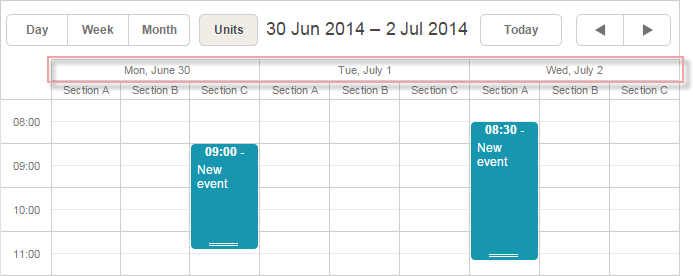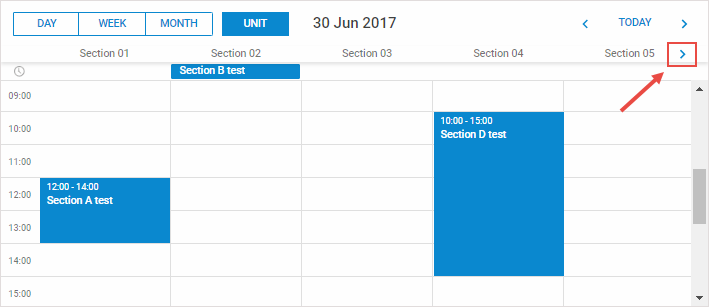Available only in PRO Edition
Units 视图
此视图仅在 Scheduler PRO 版本中提供。
Units 视图根据事件的特定属性(而不仅仅是时间)来组织 X 轴。

初始化
要将 Units 视图添加到调度器,请按照以下步骤操作:
- 在页面上启用 Units 扩展:
scheduler.plugins({ units: true });
- 将视图的选项卡添加到调度器的标记中:
<div id="scheduler_here" class="dhx_cal_container" ...> <div class="dhx_cal_navline"> ... <div class="dhx_cal_tab" name="unit_tab" style="right:280px;"></div> </div> ... </div>
- 为选项卡设置标签:
//'unit_tab' 是我们 div 的名称 scheduler.locale.labels.unit_tab = "Unit"
- 使用 createUnitsView 方法创建视图:
scheduler.createUnitsView({ name:"unit", property:"unit_id", // 映射单位的事件属性 list:[ // 定义视图中显示的单位 {key:1, label:"Section A"}, {key:2, label:"Section B"}, {key:3, label:"Section C"} ] });
向视图加载数据
与 Day、Month 或 Year 等标准视图不同,Units 和 Timeline 等多资源视图要求事件包含一个额外的必填字段:
- property - (string) 用于将事件分配到特定单位的数据属性名称
scheduler.createUnitsView({
name:"unit",
property:"unit_id",
list:[
{key:1, label:"Section A"},
{key:2, label:"Section B"},
{key:3, label:"Section C"}
]
});
scheduler.init('scheduler_here');
scheduler.parse([
{id:1, text:"Task1", start_date:"2019-09-17 12:00", end_date:"2019-09-18 21:00",
unit_id:"1"},
{id:2, text:"Task2", start_date:"2019-09-17 09:00", end_date:"2019-09-17 21:00",
unit_id:"3"},
{id:3, text:"Task3", start_date:"2019-09-17 15:00", end_date:"2019-09-18 15:00",
unit_id:"2"}
]);
事件通过 unit_id 的值与 list.key 对应来分配到相应的单位。
动态更改分区
要在 Units 视图中动态更新单位列表,可以使用 serverList 和 updateCollection 方法。
多天单位显示
要显示跨越多天的单位,请使用 days 参数:
scheduler.createUnitsView({
name:"week_unit",
property:"section_id",
list:sections,
days:3 });

Related sample: Multiday Units view
这样会增加一个显示日期的第二层横向刻度。
如需自定义第二层刻度的显示格式,可使用 scheduler.templates[name+"_second_scale_date"] 模板:
scheduler.templates.units_second_scale_date = function(date) {
return scheduler.templates.week_scale_date(date);
};
注意:
- 第一层刻度照常通过 scale_text_template 定义。其高度可通过 scale_height 调整。
- 可参考 在视图的 X 轴上隐藏时间单位 中的方法,在第二层横向刻度中隐藏不需要的时间单位。
- size 和 step 参数不适用于多天单位。
- PDF 导出仅支持 新服务,不支持 旧版导出工具。
- 如需调整显示区间的起始日,请使用 scheduler.date.{units_name}_start 函数:
scheduler.date.units_start = function (date) { return scheduler.date.week_start(date); };
为事件分配多个单位
从 4.1 版本开始,可以将事件同时分配到多个单位。

启用此功能的方法:
- 在页面上激活 Multisection 扩展
- 将 multisection 属性设置为 true
- (可选)启用 "multiselect" 扩展,以便使用 Multiselect(多选控件) 控件更方便地切换分区
<script src="codebase/dhtmlxscheduler.js"></script>
<link rel="stylesheet" href="codebase/dhtmlxscheduler.css" type="text/css">
<script>
scheduler.plugins({
multisection: true, multiselect: true,
units: true
});
scheduler.config.multisection = true; scheduler.init('scheduler_here');
</script>
之后,可以在事件对应属性中指定多个分区(默认用逗号分隔,参见 section_delimiter),事件将在所有这些单位中显示:
scheduler.createUnitsView({
name: "unit",
list: [
{key: 1, label: "James Smith"},
{key: 2, label: "John Williams"},
{key: 3, label: "David Miller"},
{key: 4, label: "Linda Brown"}],
property: "section_id", ...
});
scheduler.init('scheduler_here', new Date(2019, 5, 30), "unit");
scheduler.parse([
{ id:1, text:"Task A", section_id:'1', ...}, { id:2, text:"Task B", section_id:'1,3', ...}, { id:3, text:"Task C", section_id:'4', ...}, { id:4, text:"Task D", section_id:'2,3,4', ...}]);
Related sample: Multisection events in Timeline and Units view
X 轴分区的数据
X 轴上显示的值通过 list 参数设置:
scheduler.createUnitsView({
name:"unit",
...
list:[
{key:1, label:"Section A"},
{key:2, label:"Section B"},
{key:3, label:"Section C"}
]
});
list 中的每一项都必须包含两个必需属性:
- key - 唯一标识符
- label - 显示名称
从服务器获取 X 轴分区数据
如需从服务器加载分区数据,请使用:
- 客户端 - serverList 方法:
scheduler.createUnitsView({
name:"unit",
property:"type_id",
list:scheduler.serverList("units"),
size:20,
step:1
});
其中 serverList 返回名为 'units' 的列表。
- 服务器端
load 方法的响应应包含带有服务器列表名称的集合,JSON 格式如下:
{
"data":[
{
"id":"1",
"start_date":"2019-03-02 15:00:00",
"end_date":"2019-03-04 16:00:00",
"text":"Team meeting",
"type_id":"1"
},
{
"id":"2",
"start_date":"2019-03-02 17:00:00",
"end_date":"2019-03-04 18:00:00",
"text":"Strategy meeting",
"type_id":"2"
}
],
"collections": { "units":[ {"value":"1","label":"Conference room 1"}, {"value":"2","label":"Conference room 2"}, {"value":"3","label":"Conference room 3"} ] }}
或者,可以使用 OptionsConnector 连接器:
<?php
include('connector-php/codebase/scheduler_connector.php');//包含文件
$res=mysql_connect("localhost","root","");//连接数据库服务器
mysql_select_db("sampleDB");//连接数据库,'sampleDB' 为数据库名
$list = new OptionsConnector($res, $dbtype);
$list->render_table("types","type_id","type_id(value),name(label)");
$scheduler = new schedulerConnector($res, $dbtype);
//设置与客户端相同的名称 - 'units'
$scheduler->set_options("units", $list);
$scheduler->render_table("events","id","start_date,end_date,text,type_id");
?>

你也可以不使用 dhtmlxConnector,手动构建集合。在这种情况下,可使用 updateCollection 方法更新集合:
scheduler.updateCollection("units", new_sections_array);
Related sample: Loading Units sections from the server
单位滚动
当单位数量较多时,可通过 size 和 step 属性启用横向滚动:
scheduler.createUnitsView({
name:"unit",
...
size:10, // 一次可见的单位数
step:5 // 每次滚动的单位数
});

Related sample: Horizontal scrolling sections in Units view
跳过不属于任何单位的事件
默认情况下,不匹配任何已定义单位的事件会显示在第一个单位中。从 3.0 版本开始,可以选择完全跳过这些事件。
要启用此功能,请设置 skip_incorrect 属性:
scheduler.createUnitsView({
name:"unit",
...
skip_incorrect:true
});